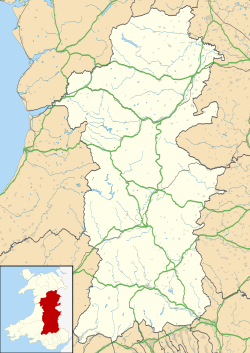Erwood
| |
|---|---|
| Community | |
 Erwood post office | |
Location within Powys | |
| Principal area | |
| Country | Wales |
| Sovereign state | United Kingdom |
| Police | Dyfed-Powys |
| Fire | Mid and West Wales |
| Ambulance | Welsh |
Erwood (Welsh : Erwyd) is a village and community lying beside the River Wye, on the A470 road some 6 miles south-east of Builth Wells in Powys, Wales. The population of the community taken at the 2011 census was 429. [1] It is in the historic county of Brecknockshire (Breconshire) and the older cantref of Cantref Selyf. The community includes the settlements of Crickadarn, Gwenddwr and Llaneglwys.
Nant Clettwr, flowing from west to east before turning north through the village to join the River Wye, divides Erwood between the two parishes of Gwenddwr, to the northwest, and Crickadarn, to the southeast. The church of Saint Dubricius in Gwenddwr was extensively rebuilt in the Victorian period after a fire. [2] In former times drovers would ford the Wye at Erwood on their journey towards the English Midlands and eventually London, where they would sell their livestock. [3]
Erwood is overlooked from across the Wye by the ancient hill-fort of Twyn y Garth. [4] On its 325-metre-high summit is a German field howitzer, a trophy from World War I. The fact that it is pointing towards Erwood from the neighbouring county of Radnorshire is part of a local running joke.
At the southern end of the community, on the Nant Scithwen, is Trericket Mill where Roderick Murchison recorded in the 1830s that he had identified "the first true Silurian" crossing the river at nearby Cavansham Ferry [5] , now recognised as an internationally important IUGS geological heritage site [6] .


